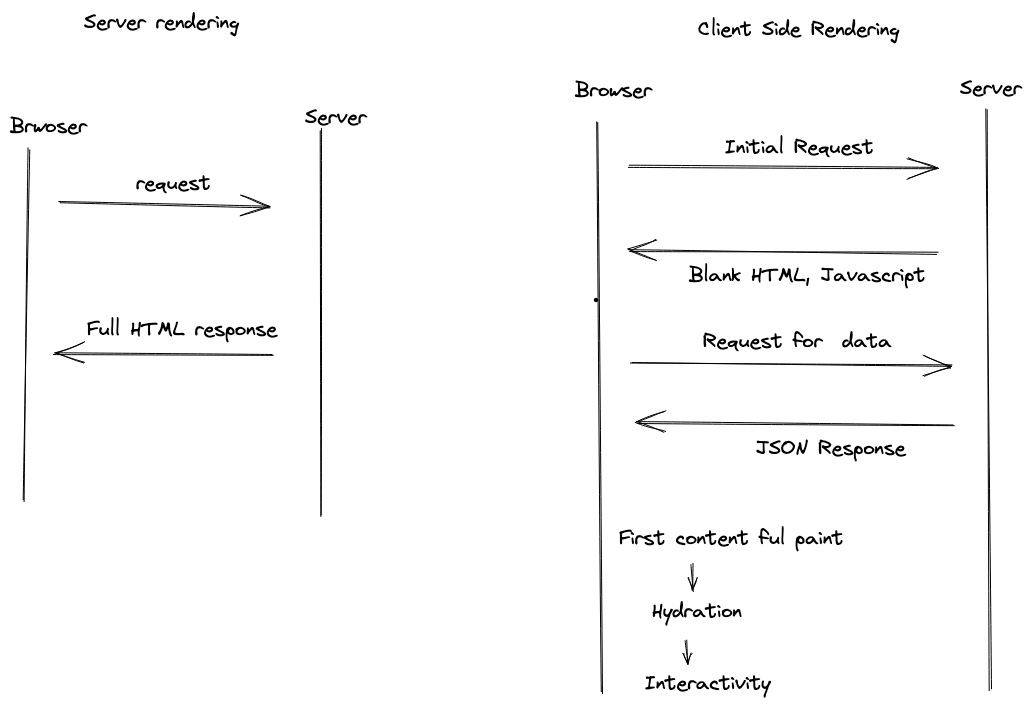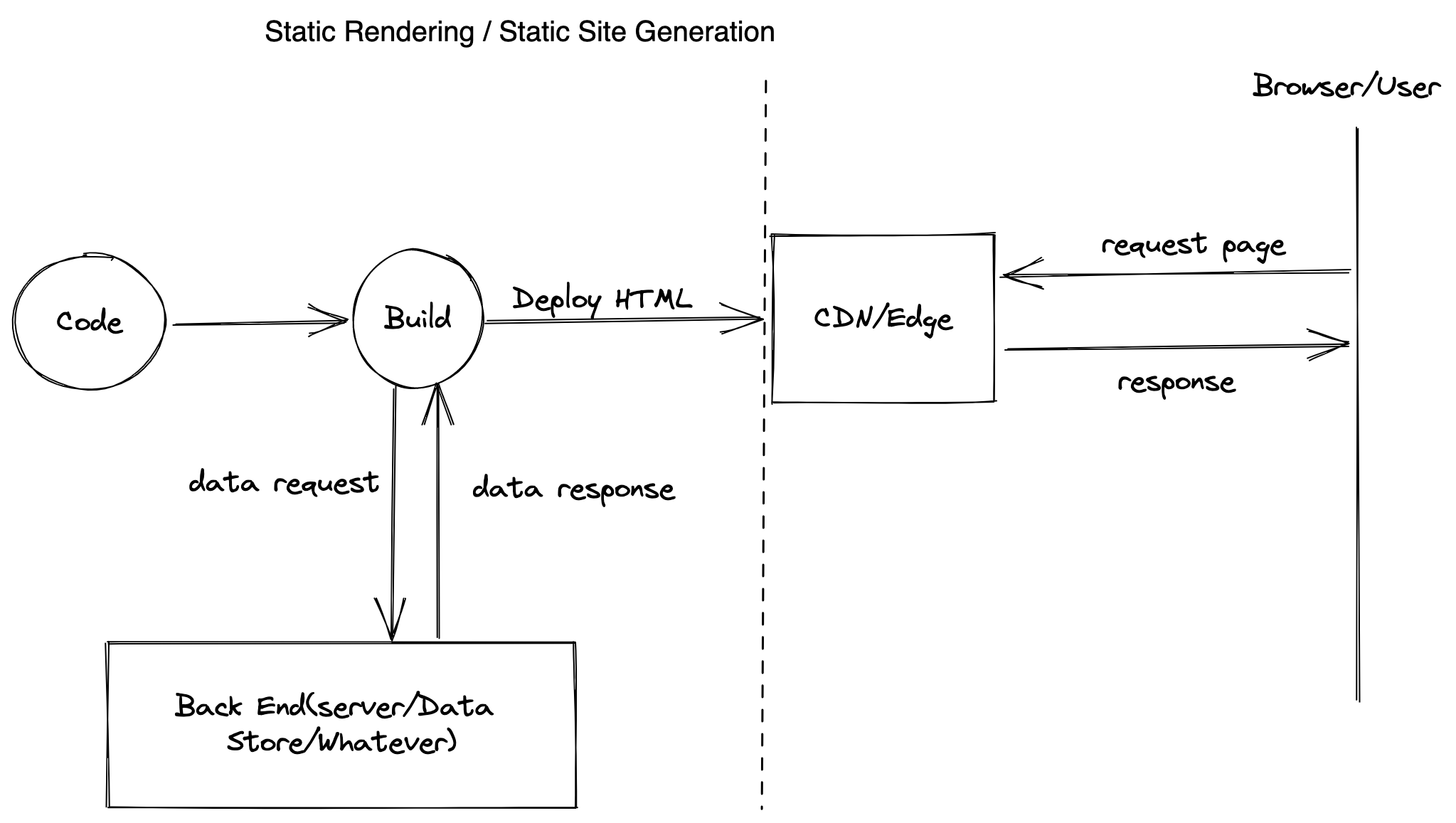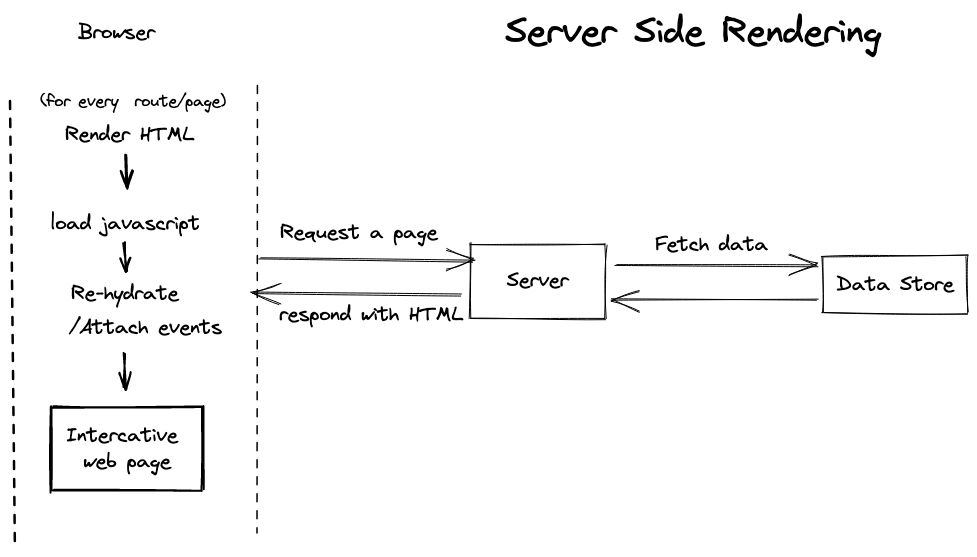

Introduction
In this post, we take a brief look at the various type of “rehydration” techniques used in web applications. Before we get into the rehydration techniques, let us see why rehydration is necessary and what type of web pages or apps needs rehydration.
Server Rendering
A decade ago, the majority of web pages in the web were server-rendered. By rendering we mean the process constructing the HTML page, with the data that user needs. In server rendering (old school rails, PHP, asp.net etc), the server-side code gets the data from the database, uses that data to create an HMTL page and sends that HTML back to the user. When a user needs more data, a new request is made, the entire page is again sent back (with new data) to the browser and as result the page reloads. This is how things worked a while ago.
Client Side Rendering
Then came client-side rendering. In client-side rendering, All logic, data fetching, templating, and routing are handled on the client rather than the server. When the page loads, the client will have a very basic HTML. It will have a script tag that loads the JS code. The JS code then fetches the data, uses the template to construct the HTML, and then updates the DOM to reflect the changes.
All modern JS frameworks pretty much work on CSR, with some variations. As you can see, CSR is way slower to load than the classic Server rendering. With core web vitals and google’s push to reward pages that perform better on their metrics, CSR became a problem. A few variations of CSR developed over time to make CSR more “performant”.

Static Rendering
Static rendering is good for pages that do not have any interactivity. The page is built during build time. The data fetching and building of nodes all happen during the build time. And then the entire app is deployed to a CDN. As you can imagine, this will make the website blazing fast as no data fetching and node construction happening in the server or the client. The downside here of course is that the pages are static. Every time we have a change, we will need to go through the build and deploy cycle.

Server Side Rendering
Universal rendering or Server Side Rendering (SSR) is an attempt to balance the trade-offs between CSR and server rendering. In SSR, full page loads and reloads are handled by the server. The server creates the full HTML and sends it back to the browser. The javascript and data for rendering are also embedded in the HTML. With SSR, we can have very fast first contentful paint(FCP). Once FCP is done, the page still needs to continue the rendering using the javascript. This is where “Rehydration” comes into the picture. With Rehydration, we add application state and interactivity to the server-rendered HTML. Even though the page may appear to be ready, due to the need for rehydration, the page won’t be ready for interaction until rehydration is complete.

(Re)Hydration
(Re)Hydration is the name given to the process in JavaScript frameworks to initializing the page in the browser after it has previously been server rendered.
There are three main things that reydration does for the page,
- Add listeners. This will make the page ready for interaction.
- For frameworks like React, the app needs to build the component tree again in the client side. Becuase the framework needs its internal data structur ready to continue to fetch and render new items based on user interaction.
- The app also needs to restore its application state, so that its internal state reflects what is rendered on the page.

Since we are essentially trying to get the client to the same state as the server, this is also known as “replaying”. Generally, frameworks that support SSR are replayable.
This comes witha cost and will lead to the following situation.
In SSR,
- You have to fetch everything before you can show anything.
- You have to load everything before you can hydrate anything.
- You have to hydrate everything before you can interact with anything.
This is due to the waterfall like situation, where one thing depends on the other as shown in the below image.

Additionally, for non trivial applications, the size of the javascript bundle would be significant.The major portion of the load time will be spent on downloading the javascript required to run the app. So to improve the performance of the SSR, it is imperative to improve the re-hydration as well as to reduce the bundle size.
There are a few rehydration methods that aim to improve this situation,
- Streaming server-side Rendering
- Progressive Rehydration
- Trisomorphic Rendering
- Selective Hydration
- Island Architecture
For the rest of the article, we will explore each of these items in detail.
Streaming Server-Side Rendering
Streaming SSR tries to solve the first of the three problems. ie, You have to fetch everything before you can show anything. In Streaming SSR, HTML and relevent inline javascript can be streamed to the client. What this means is, we can send a a chunk of HTML as soon as it is ready. And have place holders of the sections that may take more time to be ready. Then, when the section is ready, stream it to the client with some in line javacsript so that it is populated in the right place. This will make the Fisrt Contentful Paint even faster for the SSR. And the hydration can start as soon as the first chunk of HTML is ready. So part of the page will become intercative much earlier, compared to the regular SSR.
Progressive (and selective) Re-Hydration
Progressive hydration is another way to reduce the TTI in SSR. Here the trick is to hydrate the page before all the code has loaded. Instead of hydrating all the nodes at one go, we re-hydrate the nodes progressively, using certain conditions. For example, we may only hydrate the nodes that are visible in the viewport.Or we may hydrate the node that has a higher probabilty of getting clicked first.
In order to do that, we will have to split our js bundle into multiple chunks and lazy load the chunks based on how we want to hydrate the app.
In React, the “hydrate” method from the react-dom is used to implement progressive hydration. React.lazy and Suspense are the other two features that will help with progressive Re-Hydration.
Trisomorphic Rendering
In this technique, initial rendering is done with Streaming SSR. Subsequent rendering happens through service workers for navigation links. ie, When the user navigates to a new view, that view is loaded from the service worker instead of the server. The service worker will fetch and cache this view while the initial view was getting installed.
In order for this to work, the client, server, and service worker should all use the same routing and templating.
Island Architecture
We have looked at Island Architecture in a previous Article. Here we render HTML pages in the server and inject slots in them that can be hydrated in the client. In frameworks like astro, we can also use static rendering (compile time) with slots for “islands” of interactivity that can be hydrated in the client. Here we don’t have any re-hydration at all. The static parts that come from the server, do not have any interactive bits. So they remain static. The islands are entirely hydrated in the client, like in the case of CSR. That is why Jason Miller described it as “progressive hydration for free”.
Conclusion
We looked at what hydration is and why it is necessery. We looked at the cost and limitations of hydration and different hydration techniques that helps us overcome these problems. Finally, there are frameworks that does SSR with out any hydration. For example qwik does it by being resumable instead of replayable.